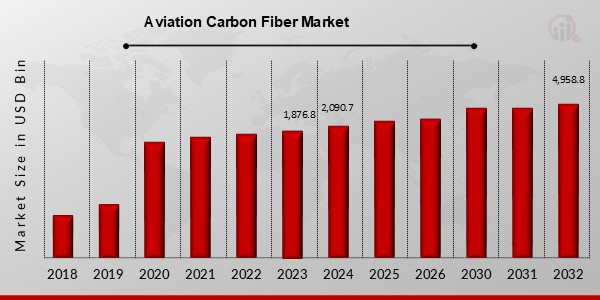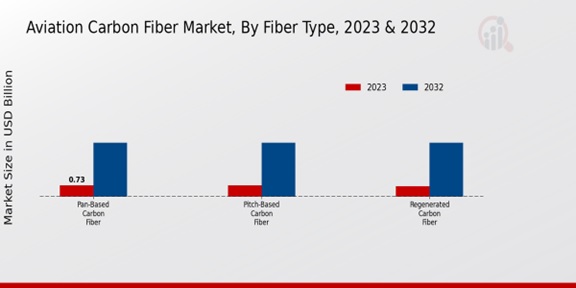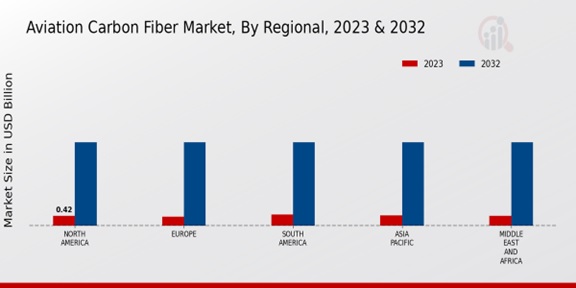Aviation Carbon Fiber Market Overview
Aviation Carbon Fiber Market Size was estimated at 1,876.8 (USD Billion) in 2023. The Aviation Carbon Fiber Market Industry is expected to grow from 2,090.7 (USD Billion) in 2024 to 4,958.8(USD Billion) by 2032. The Aviation Carbon Fiber Market CAGR (growth rate) is expected to be around 11.4o% during the forecast period (2024 - 2032).

Source Primary Research, Secondary Research, MRFR Database and Analyst Review
Key Aviation Carbon Fiber Market Trends Highlighted
Key market drivers include increasing demand for lightweight and fuel-efficient aircraft, stringent environmental regulations, and government incentives for the adoption of sustainable technologies. The rising popularity of electric and hybrid-electric aircraft is further driving demand for carbon fiber in aviation. Opportunities for growth lie in the development of cost-effective and innovative carbon fiber production technologies, as well as the expansion of applications in unmanned aerial vehicles (UAVs) and space exploration.Recent trends in the aviation carbon fiber market include the adoption of automated and robotic processes in manufacturing, the development of new carbon fiber composites and hybrid materials, and the increasing use of carbon fiber in aircraft interiors. Key market players are focusing on research and development to enhance the performance and reduce the cost of carbon fiber. The integration of additive manufacturing technologies in carbon fiber production is expected to drive innovation and efficiency gains in the future.
Aviation Carbon Fiber Market Drivers
Increasing Demand for Lightweight and Fuel-Efficient Aircraft
The aviation industry is intensely looking for ways to decrease weight and enhance fuel efficiency because of regulatory requirements and passengers’ wish to have more sustainable flights. There is no better option in the base than carbon fiber composites, which are lightweight and durable. Airlines and other aircraft research studies can cut the weight of their aircraft and work more effectively without concerns about the performance and safety of the aircraft components.It is possible to change the traditional weight of aircraft components such as wings, fuselage, or empennage to carbon fiber. As a result, weight saving is achieved with improved fuel efficiency and uniform cost of operation in the airlines. Due to the increase in demand for fuel-efficient and eco-friendly aircraft, the market for aviation carbon fiber is expected to increase to a great extent.
Growing Adoption of Advanced Manufacturing Technologies
Advanced fiber placement and resin-transferring molding are becoming popular in the Aviation Carbon Fiber Market Industry. AFP and RTM methods can produce high-quality components. The methods are also known for producing exact and efficient carbon fiber composites. In addition, this technology minimizes lead time, reducing costs for carbon fiber producers. The use of advanced manufacturing technologies will enable the aviation carbon fiber market to grow.With the increased demand for lightweight and durable aircraft components, the carbon fiber composite market will continue to grow.
Government Regulations and Environmental Concerns
There are more stringent regulations by every government in order to cut down carbon emissions and promote sustainable aviation practices. Not only the increase in demand for the most fuel-efficient and environmentally friendly aircraft is putting pressure on aircraft manufacturers to use carbon fiber composites, but the regulations of carbon emissions are also encouraging the use of carbon fiber composites to reduce the weight of aircraft and, thereby, fuel consumption.The increasing concern for the environment by passengers is also encouraging the airlines to use carbon fiber composites. There are also government initiatives and regulations regarding carbon emissions and the reduction of aviation waste, which are expected to take the aviation carbon fiber market to a higher level.
Aviation Carbon Fiber Market Segment Insights
Aviation Carbon Fiber Market Fiber Type Insights
Fiber Type Segment Analysis The PAN-based Carbon Fiber held a significant share of the aviation carbon fiber market in 2023 and is expected to remain the largest segment during the assessment period. The PAN-based carbon fiber has strong and stiff features at low density in comparison to other composite materials, which is why it is used in aircraft structural components such as wings, fuselages, and empennages. Moreover, the increasing acceptance by aerospace industries across various countries is the responsible factor for the demand for this segment. In the aviation carbon fiber market, the pitch-based carbon fiber segment is the other most popular type of fiber. The demand for this type of fiber in the market is anticipated to witness the highest growth rate. The pitch-based carbon fibers are derived from petroleum and display high thermal stability and electrical conductivity. Therefore, these fibers are usually used in aircraft brake systems and other high-temperature applications. The Regenerated Carbon Fiber is a relatively new type of fiber and is expected to be the upcoming growing reservation segment in the aviation carbon fiber market during the assessment period from 2024 to 2032.It is commonly used to produce fiber from recycled or discarded carbon fiber products, and it displays characteristics similar to PAN-based and Pitch-based carbon fibers.

Source Primary Research, Secondary Research, MRFR Database and Analyst Review
Aviation Carbon Fiber Market Product Type Insights
Prepreg, non-woven fabric, woven fabric, and chopped carbon fiber are the four primary product types of the Aviation Carbon Fiber Market. Woven fabric is the most significant product type, holding over 50% of the market share in 2023. Woven fabric offers high strength, stiffness, and dimensional stability, making it suitable for various aviation applications, including aircraft skins, fuselage panels, and wing components. Prepreg is another crucial product type, accounting for around 25% of the market share. It is a pre-impregnated carbon fiber reinforced material that offers excellent handling characteristics and is widely used in aircraft structures, such as wing spars and ribs.Non-woven fabric and chopped carbon fiber constitute the remaining market share, finding applications in interior components, insulation, and reinforcement of composite structures. The Aviation Carbon Fiber Market is projected to grow at a steady pace in the coming years, driven by rising demand for lightweight and fuel-efficient aircraft, particularly in the commercial aviation sector.
Aviation Carbon Fiber Market End Market Insights
The Aviation Carbon Fiber Market is segmented into various end markets, including commercial aircraft, business jets, military aircraft, and rotorcraft. Among these, the commercial aircraft segment holds a significant share of the market due to the increasing demand for lightweight and fuel-efficient aircraft. The growing air passenger traffic and the need for airlines to reduce operating costs are driving the adoption of carbon fiber in commercial aircraft. Furthermore, government regulations aimed at reducing carbon emissions are also contributing to the growth of this segment.The business jets segment is expected to witness steady growth over the forecast period, driven by the rising demand for luxury and high-performance aircraft. The military aircraft segment is also expected to contribute to the growth of the market, as carbon fiber is increasingly used in military aircraft due to its high strength-to-weight ratio and durability. The rotorcraft segment is expected to witness moderate growth, primarily driven by the increasing demand for helicopters in various applications such as search and rescue, medical evacuation, and law enforcement.
Aviation Carbon Fiber Market Application Insights
The application segment of the Aviation Carbon Fiber Market is diverse, encompassing various components of aircraft structures. Fuselage, wing, tailfin, and interior applications each hold significant market shares and contribute to the overall growth of the industry. Fuselage applications account for a substantial portion of the market, driven by the need for lightweight and durable materials to enhance aircraft performance. Carbon fiber's high strength-to-weight ratio makes it an ideal choice for fuselage construction, enabling airlines to reduce fuel consumption and increase payload capacity.Wings, another critical application segment, utilizes carbon fiber's stiffness and strength to optimize aerodynamic efficiency. Carbon fiber wings reduce drag and improve aircraft stability, contributing to enhanced fuel efficiency and reduced operating costs. Tailfin applications also benefit from carbon fiber's lightweight properties. Tailfins constructed from carbon fiber enhance aircraft maneuverability and stability, enabling precise control during flight. Interior applications of carbon fiber are gaining traction due to their aesthetic appeal and durability.This growth is driven by increasing demand for fuel-efficient and lightweight aircraft, as well as the growing adoption of carbon fiber composites in various aviation applications.
Aviation Carbon Fiber Market Aircraft Size Insights
The Aviation Carbon Fiber Market is segmented by aircraft size into narrow-body aircraft and wide-body aircraft. Narrow-body aircraft are smaller and have a single aisle, while wide-body aircraft are larger and have two aisles. In 2023, the narrow-body aircraft segment accounted for a larger share of the aviation carbon fiber market, and this trend is expected to continue in the coming years. This is due to the increasing demand for narrow-body aircraft from low-cost carriers and regional airlines. The wide-body aircraft segment is also expected to grow, but at a slower pace, as airlines focus on expanding their narrow-body fleets.Overall, the Aviation Carbon Fiber Market is expected to grow at a CAGR of 5.71% from 2024 to 2032, reaching a valuation of USD 3.5 billion by 2032.
Aviation Carbon Fiber Market Regional Insights
The regional segmentation of the Aviation Carbon Fiber Market offers valuable insights into the market's geographical distribution and growth potential. North America is projected to dominate the market with a significant revenue share in 2024, driven by the presence of major aircraft manufacturers and a growing demand for lightweight and fuel-efficient aircraft. Europe holds the second-largest market share, supported by stringent regulations on emissions and a robust aerospace industry. The Asia-Pacific (APAC) region is poised for rapid growth, fueled by the expanding aviation sector and government initiatives to promote sustainable aviation.South America, the Middle East, and Africa (MEA) are expected to contribute a smaller share to the market but present emerging opportunities for growth.

Source Primary Research, Secondary Research, MRFR Database and Analyst Review
Aviation Carbon Fiber Market Key Players And Competitive Insights
It is important to note that meeting the constantly growing demand for lightweight and durable materials in the aviation sector has become one of the essential goals for major participants in the Aviation Carbon Fiber Market. In addition, major players aim to expand their product offerings further and constantly invest in technology in order to improve quality and lower prices. In particular, among the main trends that are expected to drive the growth of the market, the increasing demand for environmentally sound and eco-friendly technologies should be underlined. In addition, given the fact that the level of competition in the current market is extremely high, such a state of affairs stimulates major participants to further improve the quality of their products and services and provide clients with substantial discounts, which is beneficial for them. Moreover, it is important to note that despite the growing levels of demand, the number of substitutes in the market is limited, which allows for maintaining the level of prices for the end customers at a stable level.It is evident that one of the main players in the market is the Hexcel Corporation, which considers the expansion of its product offerings and investment in the development of new products to be one of the essential parts of the company's strategy. Apart from different types of prepregs, this supplier offers a range of products, including reinforcements and honeycomb constructions. In addition, it is crucial to point out that this company has a significant international presence as it has operating units in North America, Europe, and Asia.Another major participant in the market, the main range of product offerings, which includes different kinds of prepregs, fibers, and composites, is Toray Industries, Inc. This company has a significant presence as its operating units are located in North America, Europe, and Asia. In addition, it is essential to point out that Toray Industries, Inc. pays a lot of attention to research and development work in order to ensure the high quality of products that are offered to customers.
Key Companies in the Aviation Carbon Fiber Market Include
- SGL CARBON SE
- Mitsubishi Rayon Co., Ltd.
- Chomarat Group
- Aernnova Aerospace
- Hexcel Corporation
- Zoltek Companies Incorporated
- Mitsubishi Chemical Corporation
- TORAY INDUSTRIES, INC.
- Formosa Plastics Corporation
- Solvay
- Cytec Industries Inc.
- Gurit Holding AG
- Park Aerospace Corp
- HEXCEL COMPOSITES LTD
- Teijin Limited
Aviation Carbon Fiber Market Industry Developments
Recent developments in the aviation carbon fiber market include increased demand for lightweight and fuel-efficient aircraft, advancements in carbon fiber production technology, and government regulations promoting sustainable aviation practices. Major players in the market are investing in research and development to enhance the performance and affordability of carbon fiber composites. Strategic partnerships and acquisitions are also shaping the market landscape. Market analysts anticipate continued growth in the adoption of carbon fiber in aircraft manufacturing, driven by the need for improved aircraft performance and reduced emissions.
Aviation Carbon Fiber Market Segmentation Insights
Aviation Carbon Fiber Market Fiber Type Outlook
- PAN-based Carbon Fiber
- Pitch-based Carbon Fiber
- Regenerated Carbon Fiber
Aviation Carbon Fiber Market Product Type Outlook
- Prepreg
- Non-woven Fabric
- Woven Fabric
- Chopped Carbon Fiber
Aviation Carbon Fiber Market End Market Outlook
Aviation Carbon Fiber Market Application Outlook
- Fuselage
- Wing
- Tailfin
- Interior
Aviation Carbon Fiber Market Aircraft Size Outlook
- Narrow-body Aircraft
- Wide-body Aircraft
Aviation Carbon Fiber Market Regional Outlook
- North America
- Europe
- South America
- Asia Pacific
- Middle East and Africa
| Report Attribute/Metric |
Details |
| Market Size 2023 |
1,876.8 (USD Billion) |
| Market Size 2024 |
2,090.7 (USD Billion) |
| Market Size 2032 |
4,958.8 (USD Billion) |
| Compound Annual Growth Rate (CAGR) |
11.40% (2024 - 2032) |
| Report Coverage |
Revenue Forecast, Competitive Landscape, Growth Factors, and Trends |
| Base Year |
2023 |
| Market Forecast Period |
2024 - 2032 |
| Historical Data |
2019 - 2023 |
| Market Forecast Units |
USD Billion |
| Key Companies Profiled |
SGL CARBON SE, Mitsubishi Rayon Co., Ltd., Chomarat Group, Aernnova Aerospace, Hexcel Corporation, Zoltek Companies Incorporated, Mitsubishi Chemical Corporation, TORAY INDUSTRIES, INC., Formosa Plastics Corporation, Solvay, Cytec Industries Inc., Gurit Holding AG, Park Aerospace Corp, HEXCEL COMPOSITES LTD, Teijin Limited |
| Segments Covered |
Fiber Type, Product Type, End Market, Application, Aircraft Size, Regional |
| Key Market Opportunities |
Lightweight materials Fuel efficiency Increased demand for air travel Growing aerospace industry Composites Electrification of aircraft Sustainability Reduced carbon footprint |
| Key Market Dynamics |
Rising government regulations on carbon emissions Technological advancements in carbon fiber production Increasing demand for lightweight and fuel-efficient aircraft Growing adoption of carbon fiber in aircraft components Strategic partnerships and investments in carbon fiber manufacturing |
| Countries Covered |
North America, Europe, APAC, South America, MEA |
Frequently Asked Questions (FAQ) :
The Aviation Carbon Fiber Market is expected to reach an overall valuation of 2.12 Billion USD in 2023.
The Aviation Carbon Fiber Market is expected to reach an overall valuation of 3.5 Billion USD by 2032.
The Aviation Carbon Fiber Market is expected to grow at a CAGR of 5.71% from 2024 to 2032.
North America is expected to dominate the Aviation Carbon Fiber Market, followed by Europe and Asia-Pacific.
Carbon fiber is primarily used in the aviation industry for the manufacturing of aircraft components such as airframes, wings, and fuselages due to its high strength, lightweight, and durability.
Major players in the Aviation Carbon Fiber Market include Toray Industries, Mitsubishi Chemical Corporation, Hexcel Corporation, Teijin Limited, and SGL Carbon SE.
The growth of the Aviation Carbon Fiber Market is driven by increasing demand for lightweight and fuel-efficient aircraft, rising production of commercial aircraft, and technological advancements in carbon fiber production.
The Aviation Carbon Fiber Market faces challenges such as high raw material costs, complex manufacturing processes, and stringent regulations.
Opportunities for the Aviation Carbon Fiber Market lie in the development of new applications, increasing demand for sustainable materials, and technological advancements in carbon fiber production.
decline in air travel and the slowdown in the production of commercial aircraft.

















